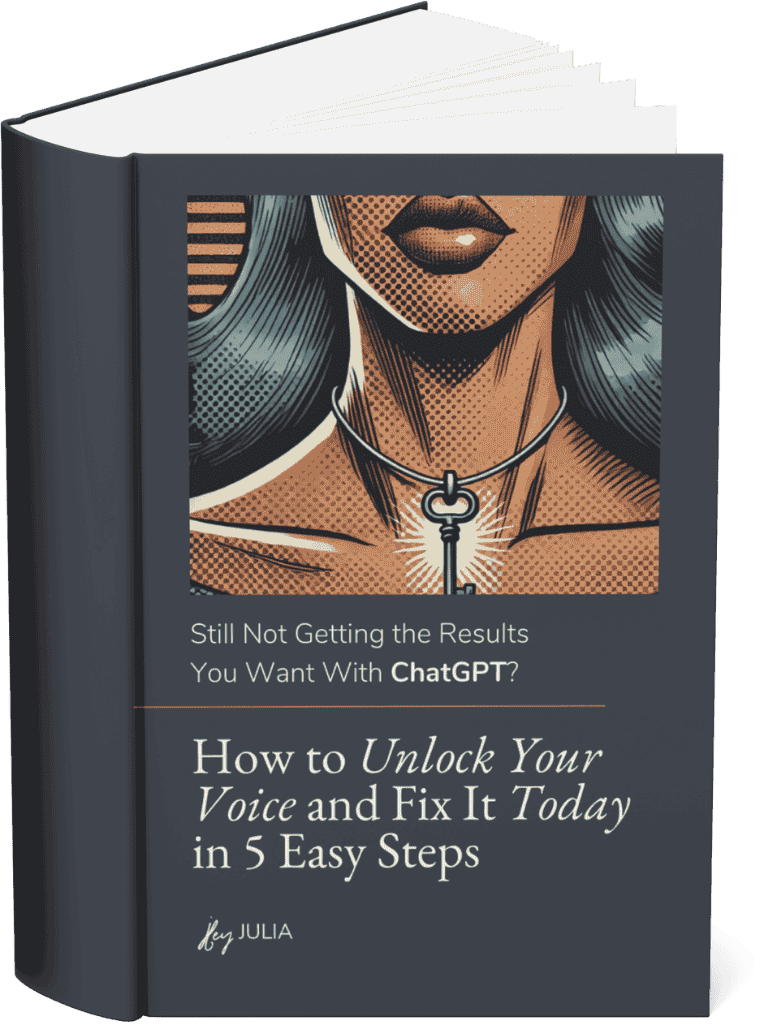Imagine opening your favourite podcast app and settling in to hear a familiar voice. The cadence, the warmth, and the storytelling style all feel like the host you know – yet behind the scenes, it isn’t their vocal cords doing the work. Instead, an algorithm trained on hours of recordings is reading the script. The words are theirs, the opinions are theirs, but the sound you hear is generated by artificial intelligence. This experiment in AI voice authenticity is more than a party trick; it’s a window into the future of content creation and client communication.
I recently tried this myself while on holiday. Rather than skipping an episode or rushing through a late‑night recording, I trained a voice model using my own audio. The result? A convincing digital version of me that could deliver a 25‑minute podcast. The experience sparked big questions: what makes a voice feel real? When does efficiency compromise connection? And how can coaches and innovators use voice cloning responsibly? In this blog post we’ll unpack those questions, drawing on research and real‑world examples to help you decide where AI fits in your business.
Why AI Voice Authenticity Matters
Your voice carries more than words. Tone, pace, and pauses are signals of how you feel. When you leave a voice note for a client, the way you breathe between sentences reveals hesitation or confidence. When you laugh in the middle of a story, it invites your listener into the moment. Modern voice cloning technology aims to capture those nuances. Instead of the robotic monotones of early text‑to‑speech systems, AI now replicates unique vocal qualities, including subtle inflections and rhythm ElevenLabs. These advancements mean synthetic speech can feel almost human.
But authenticity isn’t just about flawless delivery. Many of us value the little imperfections that make a voice memorable. A quiver when sharing something vulnerable, the occasional throat clear, or the way a sentence speeds up when excitement builds—these tell a story beyond the script. When an AI engine smooths out those quirks, something intangible can be lost. For coaches and mentors, whose voices often hold space for emotion, that loss can have real consequences. Part of the art of coaching is being present with your clients in all your human messiness. It raises a question: do our clients want polished perfection, or do they crave the messy, heartfelt reality?
How Does AI Voice Cloning Work?
To clone a voice you need data. High‑quality recordings with minimal background noise provide the raw material. Tools like ElevenLabs offer two approaches: instant cloning and professional cloning. An instant clone can be created from about a minute of audio, while a professional clone requires at least 30 minutes—sometimes several hours—to capture the subtleties of pitch, tone, and accent ElevenLabs. Once samples are uploaded, the system analyses them. Machine learning algorithms extract features such as intonation and rhythm and train a neural network to reproduce those patterns.
The result is a digital model that can speak text you never recorded. It doesn’t simply splice words together; it synthesises speech that mimics your cadence. Providers often require verification steps to ensure you’re cloning your own voice. This safeguard helps prevent misuse, though it isn’t foolproof. It’s also worth noting that professional voice cloning can take days or even weeks of processing before the final model is ready. Providers like ElevenLabs price their services competitively, with basic usage starting at around a dollar and more advanced options available for those who need greater customisation ElevenLabs.
The Rapid Growth of Voice Cloning Technology
Voice cloning isn’t a niche hobby anymore. Industry analysts report that the AI voice cloning market is expected to grow from roughly $1.2 billion in 2023 to more than $3.8 billion by 2028—tripling in just five years MarketsandMarkets via Collabnix. Surveys indicate that over 60 percent of people have encountered AI‑generated voices without realising it, whether in virtual assistants, podcast ads, or language‑learning apps Collabnix.
This explosive growth is driven by both technical improvements and broadening use cases. In gaming, a single actor can voice multiple characters, bringing richer narratives to life. In audiobooks, synthetic narration can adapt to different languages without hiring new talent ElevenLabs. Content creators use cloned voices to maintain consistency across videos, podcasts, and social media posts. Small businesses leverage AI voices to greet customers, provide onboarding instructions, or answer frequently asked questions. Affordability plays a role too: low starting costs mean that even freelancers can experiment with voice models.
Opportunities for Coaches and Innovators
For coaches and consultants, AI voice authenticity can feel like a double‑edged sword. On one hand, it offers flexibility. Imagine you’re travelling but still want to send your client a voice note. Your AI clone can deliver the message in your tone, maintaining continuity even when your schedule is packed. You can also translate scripts into multiple languages and have them spoken in your voice, making your content accessible to a global audience. For clients with hearing impairments or language barriers, text‑to‑speech and speech‑to‑text options can enhance inclusivity.
Innovators and tech‑focused entrepreneurs see scalability. They can build onboarding flows, training modules, or customer support tools that speak with a consistent brand voice 24/7. In gaming and film, voice cloning lets creators populate worlds with diverse characters while controlling quality and budget. For small businesses, it’s a way to elevate professionalism without hiring a full production team. And for people with degenerative conditions, voice cloning preserves their own voice for future communication, offering a profound kind of digital legacy.
Ethical Concerns and the Trust Question
New technology always invites misuse alongside innovation. Deepfake scams are a real and growing problem. In 2024 the U.S. Federal Communications Commission ruled that AI‑generated voice calls are considered robocalls and are illegal unless the recipient has given explicit consent Federal Communications Commission. The ruling acknowledges that scammers are using voice cloning to mimic celebrities, government officials, or even family members. They might impersonate a distressed relative asking for money or endorse fake charities using a familiar voice. Regulators are cracking down, but awareness and caution remain essential.
Beyond legal issues, there’s the human layer of trust. Will clients feel betrayed if you use an AI voice without telling them? Does transparency affect how they perceive your expertise? Authenticity isn’t only about how we sound; it’s about being honest about our processes. If your brand is built on vulnerability and connection, disclosing the use of a synthetic voice might strengthen rather than weaken trust. On the other hand, if your audience values efficiency over intimacy, the origin of the sound may be less important as long as the content serves them well.
Finding Your Balance: Authenticity versus Efficiency
So how do you decide whether to use a voice clone? Start by clarifying your intention. Is the goal to make content accessible when you can’t be at the mic? Or are you trying to automate away personal interaction? Tools should support your purpose, not replace you entirely. Many coaches are choosing a hybrid approach: they use synthetic voices for evergreen content—like welcome messages or course intros—but record live when sharing personal stories or feedback.
Here are some principles that can help you navigate the ethical and practical considerations:
- Get consent and own your data. Only clone voices you have permission to use. Providers verify ownership, but you should also obtain clear consent from collaborators.
- Provide diverse training samples. Include a range of emotions and contexts in your recordings. A varied dataset leads to a more natural‑sounding clone.
- Be transparent. Let your audience know when you’ve used a synthetic voice. Honesty nurtures trust and reduces the risk of misunderstanding.
- Use AI to support, not to substitute. Lean on technology for convenience—such as updating a video script—while maintaining direct human contact for coaching calls and personal messages.
- Stay informed about regulations. Laws evolve quickly. Keep an eye on local and international guidelines so that you remain compliant FCC.
Questions to Ask Yourself Before Cloning Your Voice
Self‑reflection is key. Consider these questions before you dive in:
- Would I be comfortable with a machine speaking for me on a bad day as well as a good one?
- What does my audience value more—polished consistency or raw honesty?
- If my voice exists in a digital library, how will I protect it from misuse?
- How will I disclose the use of AI voices in my work, and how might that impact trust?
Conclusion: Human at the Heart
Technology can amplify our voices, but it can’t replace our humanity. AI voice authenticity sits at the intersection of efficiency and connection. When used thoughtfully, synthetic voices can help you serve your clients better, reach new audiences, and preserve your energy. When used carelessly, they can erode trust and open doors to exploitation. The choice isn’t between embracing or rejecting AI; it’s about integrating it in ways that honour your values. Keep your clients in mind, stay informed, and let your heart—not just your efficiency metrics—guide your decisions.
Finally, if you’re intrigued by the idea of blending authenticity with automation, I invite you to explore The Content Creation Conversation™. It’s a program designed to help entrepreneurs build systems that free up time while keeping their voice front and centre. You’ll learn how to leverage tools like AI ethically, automate up to 80 percent of your content process, and still show up as the real you. You can find out more at contentcreationconversation.com. And if you’ve ever experimented with voice cloning or have thoughts about this emerging space, please share them in the comments. Let’s start a dialogue about what authenticity means in a world where machines can talk like us.


